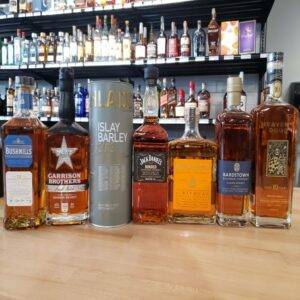Heard of Maker’s Mark, Jim Beam, Buffalo Trace, or Woodford Reserve? Those are some of the most popular brands of bourbon whiskey, and all of these distilleries are in Kentucky, where most of America’s Bourbon is made. But what is Bourbon? What makes Bourbon whiskey unique from other whiskey, and what’s its story? Let’s take a sip from this unique beverage’s history.
Origins
It is believed the vision of Bourbon had its actual start in Virginia in the year 1622. That’s when a European settler named Captain George Thorpe discovered the riches the New World had to offer. In short, the corn in America flourished better than the barley that Europe used to create their beer and spirits. He wrote to London about this corn and mentioned that it could be used in a drink to raise morale and be a better alternative to the unsafe water in Great Britain, which caused a high death rate during that time.
Corn is an essential ingredient to what Bourbon has become. Thorpe owned a still near Jamestown, Virginia, and while he wasn’t a professional distiller, he could be called a forefather of modern Bourbon. Unfortunately, he didn’t live to see his legacy play out, as he was killed (along with several other colonists) by the nearby indigenous Powhatan people. Whatever spirit he distilled was miles away from what modern Bourbon is today. (1)

The origins of distilling Bourbon have been attributed to the Scots-Irish settlers in Kentucky several years later in the late 1800s. However, much of the documentation of Bourbon is very limited, and there are debates and conflicts among legends and claims. Elijah Craig, whose Bourbon is still made today, has been claimed to be the inventor of bourbon whiskey. But there is another distiller, Jacob Spears, who claims to be the first to label one of his spirits as bourbon whiskey. While others argue that there is ‘no single inventor’ of bourbon whiskey. (2)
In 1964, The U.S. House of Representatives declared that Bourbon is a distinctive product of the United States. The resolution states that: “Whereas “Bourbon whiskey” is a distinctive product of the United States and is unlike other types of alcoholic beverages, whether foreign or domestic; and Whereas to be entitled to the designation “Bourbon whiskey,” the product must conform to the highest standards and must be manufactured in accordance with the laws and regulations of the United States which prescribe a standard of identity for “Bourbon whiskey.”
To summarize, the resolution says only the United States can produce Bourbon. At this time, Bourbon was the highest-selling liquor in the United States, even after prohibition and the second world war. (3)
Bourbon Vs. Whiskey

What makes Bourbon different than all the other whiskey? There are a few fundamental rules for a whiskey to be a bourbon. The biggest one is that Bourbon has to be made up of at least 51% corn, unlike other styles of whiskey. The rest of the mash (grain mixture) is usually made with rye, wheat, and malted barley. Despite most Bourbon being made in Kentucky, it just has to be made in the United States. (Though some may argue it has to be made in Kentucky).
The aging process must occur in a new charred oak barrel and be aged for at least two years to be considered straight Bourbon. The Bourbon cannot enter the barrel higher than 125 proof and cannot enter the bottle at less than 80 proof. Lastly, only water can be added to Bourbon, and only to lessen the proof. Other whiskies may add color or flavor, but Bourbon must be au naturel. (4)
Taste-wise, Bourbon is usually sweeter than most other styles of whiskey. Bourbon is also known to have a savory taste. That is because of its higher corn content since corn is naturally sweet. Bourbon can be smooth or harsh on the palate. It often has a “heat” to it and can have hints of caramel, vanilla, brown sugar, and spice.
Conclusion
Bourbon is an American whiskey. Its history is not very clear and is going to remain a debate about who invented it. But this type of whiskey has been solidified as a uniquely American product. It is a sweeter whiskey hailing from Kentucky and across the South and remains a popular beverage today.
Sources:
- Mitenbuler, Reid. Bourbon Empire: The Past and Future of America’s Whiskey. 2015
- John E. Kleber, ed., The Kentucky Encyclopedia(Lexington: University Press of Kentucky, 1992), 103
- https://www.govinfo.gov/content/pkg/STATUTE-78/pdf/STATUTE-78-Pg1208-2.pdf
- https://www.cnbc.com/2015/06/04/5-rules-that-make-it-bourbon.html
